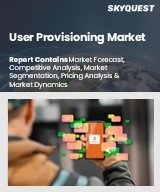
사용자 프로비저닝 세계 시장 규모는 2023년에 85억 달러, 2024년 95억 4,000만 달러에서 2032년에는 239억 5,000만 달러로 성장하고, 예측 기간(2025-2032년) CAGR은 12.2%를 나타낼 전망입니다.
세계 사용자 프로비저닝 시장은 안전한 ID 관리에 대한 수요 증가와 기업의 클라우드 기반 서비스 도입 증가로 인해 견조한 성장세를 보이고 있습니다. 기업이 디지털 인프라를 확장함에 따라 사용자 액세스, 인증 및 역할 기반 권한을 관리하는 자동화된 사용자 프로비저닝 시스템의 필요성이 중요해지고 있습니다. 또한, IT 환경의 복잡성 증가와 더불어 GDPR(EU 개인정보보호규정), HIPAA, SOX 등의 엄격한 규제 준수 요구사항이 시장을 견인하고 있습니다. 또한, 원격 근무의 급증으로 인해 중앙 집중식 액세스 관리 및 실시간 프로비저닝 기능에 대한 요구가 증가하고 있습니다. 기업들은 확장성, 감사 추적, 여러 용도 및 플랫폼과의 통합을 제공하는 솔루션에 대한 투자를 늘리고 있으며, BYOD(Bring Your Own Device) 정책의 확산과 제로 트러스트 보안 모델로의 전환도 시장 성장에 기여하고 있습니다. 벤더들은 예측적 접근 관리를 강화하고 전반적인 보안 태세를 개선하기 위해 AI 및 머신러닝 기반 프로비저닝에 초점을 맞추었습니다.
Global User Provisioning Market size was valued at USD 8.5 billion in 2023 and is poised to grow from USD 9.54 billion in 2024 to USD 23.95 billion by 2032, growing at a CAGR of 12.2% during the forecast period (2025-2032).
The Global User Provisioning Market is witnessing robust growth, driven by the rising demand for secure identity management and increasing adoption of cloud-based services across enterprises. As organizations expand their digital infrastructure, the need for automated user provisioning systems to manage user access, authentication, and role-based permissions has become critical. The market is further propelled by the growing complexity of IT environments, coupled with stringent regulatory compliance requirements such as GDPR, HIPAA, and SOX. Additionally, the surge in remote workforces has amplified the need for centralized access management and real-time provisioning capabilities. Enterprises are increasingly investing in solutions that offer scalability, audit trails, and integration with multiple applications and platforms. The proliferation of Bring Your Own Device (BYOD) policies and the shift towards zero-trust security models are also contributing to market momentum. Vendors are focusing on AI and machine learning-driven provisioning to enhance predictive access management and improve overall security posture.
Top-down and bottom-up approaches were used to estimate and validate the size of the Global User Provisioning market and to estimate the size of various other dependent submarkets. The research methodology used to estimate the market size includes the following details: The key players in the market were identified through secondary research, and their market shares in the respective regions were determined through primary and secondary research. This entire procedure includes the study of the annual and financial reports of the top market players and extensive interviews for key insights from industry leaders such as CEOs, VPs, directors, and marketing executives. All percentage shares split, and breakdowns were determined using secondary sources and verified through Primary sources. All possible parameters that affect the markets covered in this research study have been accounted for, viewed in extensive detail, verified through primary research, and analyzed to get the final quantitative and qualitative data.
Global User Provisioning Market Segments Analysis
Global User Provisioning Market is segmented by Component, Organization Size, Vertical, Deployment Model, Function and region. Based on Component, the market is segmented into Solution and Service. Based on Organization Size, the market is segmented into Large Enterprises and Small and Medium Businesses. Based on Vertical, the market is segmented into Government, Telecom and IT, Banking, Financial Services and Insurance (BFSI), Manufacturing, Retail, Healthcare and Others. Based on Deployment Model, the market is segmented into Cloud-based and On-premise. Based on Function, the market is segmented into Finance, HR, Administration, IT and Marketing and Sales. Based on region, the market is segmented into North America, Europe, Asia Pacific, Latin America and Middle East & Africa.
Driver of the Global User Provisioning Market
The growing demand for automated user provisioning solutions is largely driven by the widespread adoption of digital transformation initiatives among businesses. Such automation enhances productivity, reduces the likelihood of human error, and accelerates compliance processes. Furthermore, a report from WorkMarket indicates that 53% of employees believe automation can free up to two hours of their workday, while 78% of business leaders estimate an even greater time savings of up to three hours daily. Companies like Okta and Microsoft have leveraged automation tools to streamline user access management, ultimately boosting operational productivity.
Restraints in the Global User Provisioning Market
The Global User Provisioning market faces significant constraints, particularly among small and medium-sized enterprises (SMEs) due to the high costs associated with deploying user provisioning solutions. Implementing these systems often requires substantial upfront investments in infrastructure, technology, and training, which can be a considerable burden for smaller organizations. A 2022 survey by the Digital Transformation Scoreboard of the European Union revealed that 62% of SMEs view these high implementation costs as a significant barrier to adoption. For instance, many smaller businesses are deterred by the substantial initial capital needed for the installation and integration of user provisioning systems like those offered by SAP.
Market Trends of the Global User Provisioning Market
The Global User Provisioning market is witnessing a notable short-term trend as businesses increasingly transition to cloud-based user provisioning systems. This movement is fueled by the need for operational efficiency and adaptability in the face of growing remote and hybrid work environments. Organizations are prioritizing solutions that offer lower operational costs, scalability, and seamless integration, reflecting a shift towards automation in user access management. Additionally, as data protection regulations evolve, companies are emphasizing enhanced security measures and reduced manual processes, positioning cloud-based systems as essential for streamlined IT operations. This trend signifies a transformation in how organizations manage user access in a modernized digital landscape.